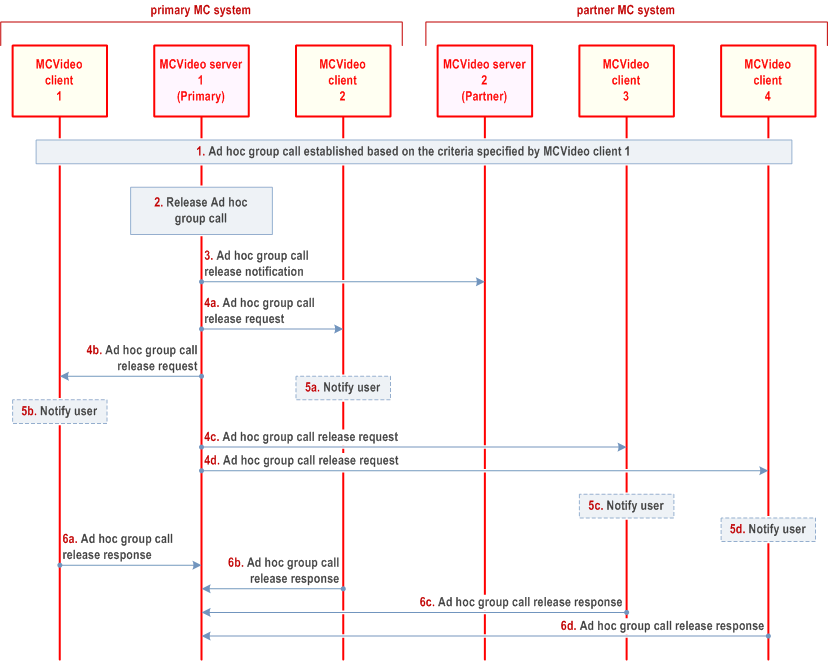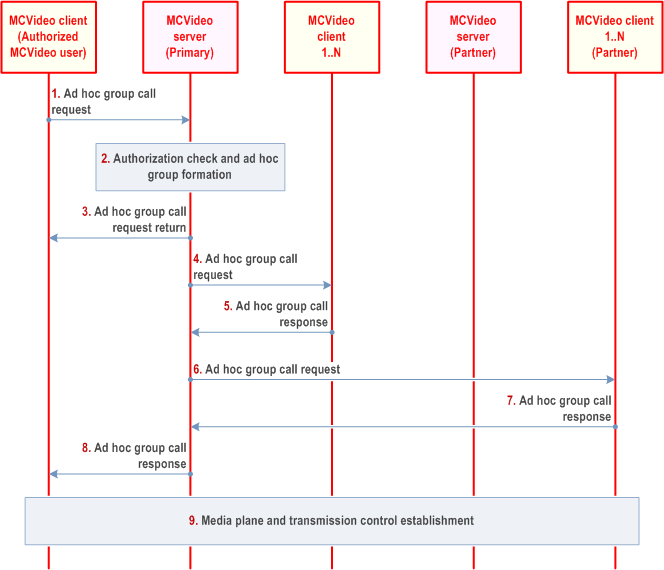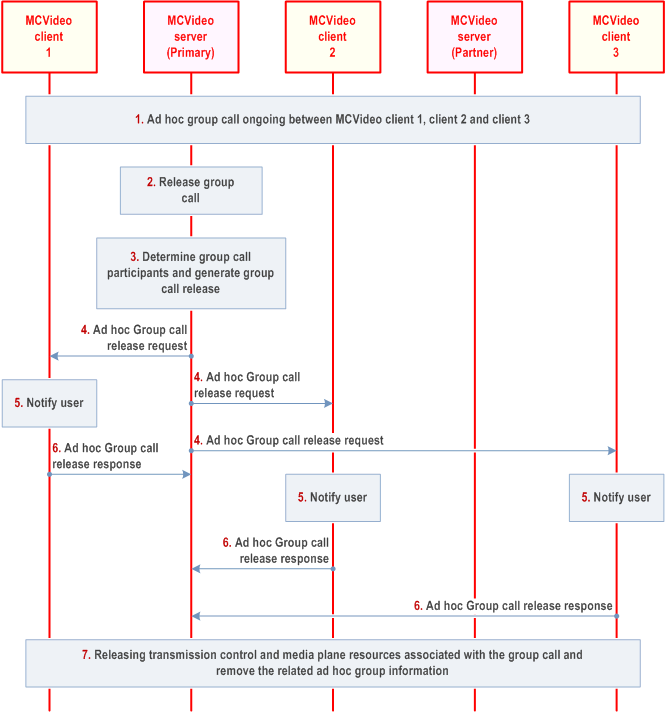Content for TS 23.281 Word version: 19.3.0
1…
5…
6…
7…
7.1.2.3…
7.1.2.3.1.2…
7.1.2.3.2…
7.1.2.4…
7.1.2.5.2…
7.1.3…
7.2…
7.2.2.3…
7.2.2.4…
7.2.3…
7.3…
7.4…
7.4.3…
7.5…
7.5.2.3…
7.6…
7.7…
7.7.1.3…
7.7.1.3.2A…
7.7.1.3.4…
7.7.1.3.6…
7.7.2…
7.7.2.7…
7.7.2.9…
7.8…
7.11…
7.17…
7.19…
7.19.2.8…
7.19.3…
7.19.3.1.4…
7.19.3.2…
7.19.3.2.3…
7.19.3.2.6…
A…
7.19.3.2.3 Release ad hoc group call and stop determining the ad hoc group call participants by partner MCVideo system - Participants list determined by the MCVideo server
7.19.3.2.4 Procedure for ad hoc group call setup - Participants list provided by the Initiator
7.19.3.2.5 Procedure for ad hoc group call release by MCVideo server - Participants list provided by the Initiator
...
...
7.19.3.2.3 Release ad hoc group call and stop determining the ad hoc group call participants by partner MCVideo system - Participants list determined by the MCVideo server p. 204
Figure 7.19.3.2.3-1 below illustrates the release of ad hoc group call and stopping of MCVideo server at the partner MC system from determining the ad hoc group call participants' procedure once involving multiple MCVideo systems. This procedure, in particular describes about how the partner MC system is notified about ad hoc group call release to cease the determining of the participants by the partner MC system.
Pre-conditions:
- The MCVideo user at MCVideo client 1 is authorized to initate ad hoc group call.
- The MCVideo server 1 of the primary and MCVideo server 2 of the partner MCVideo systems determined the participants for the ad hoc group call based on the criteria specified by the MCVideo client 1 while initiating the ad hoc group call.
- The MCVideo server 1 of the primary and MCVideo server 2 of the partner MCVideo systems continuously evaluates the criteria to monitor the list of users who meets or not meets the criteria for participating in the on-going ad hoc group call.

Step 1.
The ad hoc group call is established and on-going with the participants MCVideo client 1, MCVideo client 2, MCVideo client 3, and MCVideo client 4. The participants list is determined by both primary and partner systems MCVideo server based on the criteria specified by the MCVideo client 1 while initiating the call.
Step 2.
The MCVideo server 1 detects that the ad hoc group call which is ongoing is to be released e.g., due to hang time expiry, last participant leaving, second last participant leaving, initiator leaving, or minimum number of affiliated MCVideo group members are not present.
Step 3.
The MCVideo server 1 sends the notification to MCVideo server 2 of the partner MCVideo system about the ad hoc group call release to stop determining the participants list by MCVideo server 2 of the partner MCVideo system.
Step 4a-4d.
The MCVideo server 1 sends ad hoc group call release request to all the participants of the ad hoc group call.
Step 5a-5d.
The MCVideo clients notifies the user about the release of the ad hoc group call.
Step 6a-6d.
All the participants of the ad hoc group call receives the ad hoc group call release request and sends the ad hoc group call release response to the MCVideo server 1 of the primary MCVideo server.
7.19.3.2.4 Procedure for ad hoc group call setup - Participants list provided by the Initiator p. 206
Figure 7.19.3.2.4-1 illustrates the procedure for ad hoc group call setup procedure initiated by an authorized user wherein either a list of participants or an ad hoc group ID from an ad hoc group emergency alert is provided by the authorised user and the determined MCVideo users are from multiple MCVideo systems.
Pre-conditions:
- The security aspects of sharing the user information between primary and partner MC systems shall be governed as per the service provider agreement between them. In this case, it is considered that the partner MC system shares their users' information to the primary MC system.
- The authorized MCVideo user/dispatcher belongs to the primary MC system.
- The MCVideo server of the primary MC system is where the authorized MCVideo user/dispatcher controls the ad hoc group.
- Some users of the ad hoc group belong to partner MC systems.
- The preconfigured group identity and preconfigured group configuration to be used for an ad hoc group have been preconfigured in the MCVideo client and other participants of ad hoc group have also received the relevant security related information to allow them to communicate in an ad hoc group communication.
- If an ad hoc group ID from an ad hoc group emergency alert is used to invite the ad hoc group members, MCVideo client is aware of the ad hoc group ID.

Step 1.
The MCVideo client of the authorized user initiates an ad hoc group call with multiple users from primary and partner MC systems. An ad hoc group call request message with the information of the MCVideo IDs or an ad hoc group ID if the ad hoc group call follows an ad hoc group emergency alert is routed to the MCVideo server of the primary MC system.
Step 2.
If the ad hoc group call is supported, the MCVideo server of the primary MC system verifies whether the user at MCVideo client is authorized to initiate an ad hoc group call. If not authorized, the MCVideo server of the primary MC system rejects the ad hoc group call request as specified in the step 3.
If the information received in the request in step 1 does not contain an ad hoc group ID from an ad hoc group emergency alert, the MCVideo server of the primary MC system forms the ad hoc group by using received information. The MCData server further determines the preconfigured group to be used for the configuration and assigns an MCVideo group ID for the newly formed ad hoc group.
If no MCVideo ad hoc group ID was included in the ad hoc group call request of step 1, or if the provided MCVideo ad hoc group ID is not accepted by the MCVideo server, the MCVideo server assigns a MCVideo group ID for the newly formed ad hoc group
If the the MC service users' information received in step 1 does not contain an MCVideo ad hoc group ID from an ad hoc group emergency alert, the MCVideo server of the primary MC system forms the ad hoc group by using MCVideo users' information received in step 1, determines the preconfigured group to be used for the configuration of the ad hoc and assigns a MCVideo group ID for the newly formed ad hoc group.
The MCVideo server identifies the appropriate MCVideo server responsible for the MCVideo users of the ad hoc group. The MCVideo server considers the ad hoc group call participants as implicitly affiliated to the ad hoc group.
Step 3.
The MCVideo server shall send the ad hoc group call request return message to the MCVideo client containing the below:
Step 4.
- The MCVideo ad hoc group ID either generated by the MCVideo server or provided by the MCVideo client if the ad hoc group ID is from an ad hoc group emergency alert (only included when the ad hoc group call is authorized);
- The group ID of the pre-configured group to be used for the ad hoc group call (only included when the ad hoc group call is authorized); and
- Result of whether the ad hoc group call is authorized or not.
The MCVideo server of the primary MC system sends the ad hoc group call request to the affiliated group members of the ad hoc group belonging to the primary MC system.
Step 5.
The MCVideo clients receive in the ad hoc group call request the information of the MCVideo group ID for the ad hoc group and further notify their corresponding MCVideo user. The affiliated group members of the ad hoc group of the primary MC system may accept or reject the call and respond with the group call response.
Step 6.
The primary MCVideo server further initiates an ad hoc group call request message to the MCVideo users of the partner MC system. The ad hoc group call request message is routed to the MCVideo users via the MCVideo server of the partner MC system.
Step 7.
The MCVideo clients receive in the ad hoc group call request the information of the MCVideo group ID for the ad hoc group and further notify their corresponding MCVideo user. The MCVideo users upon receipt of the invitation may accept or reject the call, and respond with the ad hoc group call response. The ad hoc group call response message is routed to the MCVideo server of the primary MC system via the MCVideo server of the partner MC system.
Step 8.
The MCVideo server of the primary MC system provides an ad hoc group call response message to the MCVideo client of the authorized MCVideo user upon receiving response to the corresponding ad hoc group call request in step 1. The ad hoc group call response will consist of the success or failure result and/or detailed reason information in case of failure.
Step 9.
Upon successful ad hoc group call setup, a group call is established amongst the multiple group members from primary and partner MC systems. The media plane and transmission control resources are established.
7.19.3.2.5 Procedure for ad hoc group call release by MCVideo server - Participants list provided by the Initiator p. 207
This procedure focuses on the case where an MCVideo server initiates the termination of an ongoing MCVideo ad hoc group call for all the participants of that group call, since at least one of the termination conditions are met e.g., due to hang time expiry, last participant leaving, second last participant leaving, initiator leaving, or minimum number of affiliated MCVideo group members are not present.
Procedures in Figure 7.19.3.2.5-1 are the signalling control plane procedures for the MCVideo server initiating termination of an ongoing MCVideo ad hoc group call.
Pre-condition:
- The MCVideo client 1 and MCVideo client 2 belong to primary MC system. The MCVideo client 3 belongs to partner MC system.

Step 1.
The MCVideo users on MCVideo client 1, client 2 and client 3 are already part of the ongoing ad hoc group call (e.g. as a result of ad hoc group call setup as specified in clause 7.19.3.2.4).
Step 2.
The MCVideo server would like to release the ad hoc group call which is ongoing e.g., due to hang time expiry, last participant leaving, second last participant leaving, initiator leaving, or minimum number of affiliated MCVideo group members are not present.
Step 3.
The MCVideo server identifies the participants of the ongoing ad hoc group call and generates ad hoc group call release request to release ongoing session.
Step 4.
The MCVideo server sends a ad hoc group call release request via SIP core towards each participant of the ongoing group call. If the participants belong to partner MC system, then ad hoc group call release request is routed to the MCVideo clients of the partner MC system via the partner MCVideo server.
Step 5.
The MCVideo users are notified about the release of the ad hoc group call.
Step 6.
The MCVideo client(s) receiving ad hoc group call release request, send acknowledgement towards the MCVideo server by sending a ad hoc group call release response.
Step 7.
The MCVideo client 1, client 2 and client 3 have successfully released the transmission control and media plane resources associated with the ad hoc group call that is terminated. The MCVideo servers remove the ad hoc group information from the dynamic data held in the MCVideo servers and the ad hoc group ceases to exist, otherwise if the ad hoc group call follows an ad hoc group emergency alert the MCVideo servers keep the dynamic data and the ad hoc group continues to exist.